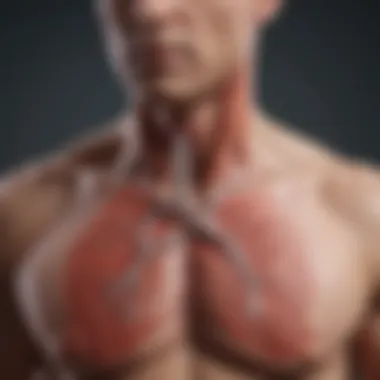Lower Your Blood Pressure with Breathing Techniques


Intro
Lowering blood pressure is essential for maintaining cardiovascular health. Hypertension affects millions of individuals worldwide and can lead to severe health complications. Many seek non-pharmaceutical approaches to manage their blood pressure effectively. Recent findings indicate that controlled breathing techniques offer promising results in this area.
Breathing exercises can lead to significant physiological changes. These changes may help lower heart rate and promote relaxation, which ultimately aids in reducing blood pressure levels. In this article, we will examine the relationship between breathing techniques and hypertension management. We will review relevant research findings and explore practical methods for daily incorporation.
Research Overview
This section outlines critical insights from studies conducted on breathing techniques and their effects on blood pressure. Understanding this relationship is vital for individuals looking to adopt a holistic approach to hypertension management.
Summary of Key Findings
Research has demonstrated that various controlled breathing methods can positively impact blood pressure. Some notable findings include:
- Diaphragmatic breathing effectively activates the parasympathetic nervous system, which induces a calming effect.
- Slow and deep breathing lowers heart rates and enhances vascular function.
- Regular practice of rhythmic breathing has been linked with long-term reductions in hypertension.
"Controlled breathing can serve as an accessible tool for managing blood pressure and improving overall well-being."
Background and Context
The urgency to control blood pressure levels stems from the increasing prevalence of stress, poor diets, and sedentary lifestyles. Traditional approaches often rely on medication, which may have limitations and side effects. As a result, there is a growing interest in alternative strategies, such as controlled breathing.
Studies in this field emphasize the importance of integrating breathing practices into everyday life. By aligning breath with bodily functions, individuals can cultivate a more balanced state of being, which may help regulate blood pressure effectively.
Methodology
This section provides an overview of the specific methodologies employed during research studies on breathing techniques and blood pressure. Understanding these methodologies is crucial for interpreting research outcomes.
Experimental Design
Many studies utilize a randomized controlled trial design to assess the effects of breathing exercises on blood pressure. Participants are often divided into groups practicing different breathing techniques and a control group that follows no such regimen. The effect on blood pressure is measured before, during, and after the intervention.
Data Collection Techniques
Data collection typically includes both qualitative and quantitative measures:
- Quantitative: Blood pressure readings are taken at regular intervals to gauge changes.
- Qualitative: Participants may report their perceived stress levels and overall well-being through surveys and interviews.
These combined approaches can provide a holistic understanding of the impact of breathing techniques on hypertension.
Prelims
In recent years, blood pressure control has become an important topic in health discussions. High blood pressure, or hypertension, is often termed the silent killer due to its ability to inflict harm without obvious symptoms. Maintaining a healthy blood pressure not only helps in reducing the risk of cardiovascular diseases but also improves overall health and well-being. This article delves into effective methods to manage blood pressure, particularly through breathing techniques.
The Importance of Blood Pressure Control
Every individual should recognize that blood pressure is a critical indicator of health. Elevated levels can lead to serious health concerns such as heart disease, stroke, and kidney failure. Effective blood pressure management can enhance quality of life. It also reduces the burden on healthcare systems. Consistent control can lead to overall well-being and longevity. Methods to lower blood pressure range from dietary adjustments to physical activity. However, breathing techniques offer a unique, often overlooked approach. By focusing on the breath, one can tap into physiological responses that contribute to lowering blood pressure naturally. This presents a simple yet powerful contribution to health management.
Breathing: A Basic Human Function
Breathing is not just a basic instinct but a foundational pillar of life. It is the process through which the body takes in oxygen and expels carbon dioxide. This exchange is vital for every function in the body. Most people breathe unconsciously, using a shallow, rapid technique that does not fully utilize lung capacity. However, understanding breathing mechanics can foster health improvements.
Controlled breathing engages a deeper diaphragm movement, which activates parasympathetic responses. This in turn reduces heart rate and promotes relaxation. By learning to breathe properly, one lays the groundwork for better physical and mental health. Breathing exercises can be easily integrated into daily routines, requiring no special equipment or extensive training. With the practice of such techniques, individuals take agency over their health, providing a proactive approach to blood pressure management.
Understanding Blood Pressure
Understanding blood pressure is crucial for anyone interested in maintaining optimal health. Blood pressure refers to the force exerted by circulating blood on the walls of the body's arteries. It is an essential indicator of cardiovascular health and can provide insight into overall health conditions.


What is Blood Pressure?
Blood pressure is measured in millimeters of mercury (mmHg) and is expressed as two numbers: systolic and diastolic. The systolic pressure is the first number, indicating the pressure in the arteries when the heart beats. The diastolic pressure is the second number which measures the pressure in the arteries when the heart is at rest between beats. Normal blood pressure usually reads around 120/80 mmHg, while readings above this can indicate health issues. Understanding these measurements helps individuals recognize when blood pressure may be outside of the normal range.
Factors Influencing Blood Pressure
Several factors can influence blood pressure, including:
- Age: As individuals age, the elasticity of blood vessels tends to decrease, which can raise blood pressure.
- Diet: High sodium intake is known to contribute to higher blood pressure.
- Physical Activity: Regular exercise helps maintain a healthy weight and promotes better heart health, directly impacting blood pressure levels.
- Stress: Chronic stress may lead to temporary spikes in blood pressure.
- Genetics: Family history can play a role in a person's predisposition to high blood pressure.
Recognizing these factors is vital for anyone looking to manage their blood pressure effectively.
Hypertension and Its Risks
Hypertension, or high blood pressure, is a serious condition that can have long-lasting health implications. It is often called the "silent killer" because it frequently has no obvious symptoms.
Risks associated with hypertension include:
- Heart Disease: Prolonged high blood pressure can lead to heart failure, coronary artery disease, and other severe conditions.
- Stroke: High blood pressure significantly increases the risk of stroke by damaging blood vessels in the brain.
- Kidney Damage: Hypertension can lead to kidney damage over time, resulting in chronic kidney disease.
Understanding the risks associated with high blood pressure is essential for preventing serious health issues. By recognizing its implications, individuals can take steps to manage their blood pressure using methods such as breathing techniques, helping support overall cardiovascular health.
The Science of Breathing Techniques
Breathing techniques serve as a bridge between the mind and body. Understanding these techniques is essential in exploring how they can help in lowering blood pressure. These methods do not just bring temporary relief but also promote long-term cardiovascular health. When properly executed, breathing exercises can modulate physiological responses and foster a more stable state of well-being.
How Breathing Affects the Body
Breathing is a vital function that regulates several bodily processes. One primary aspect is its ability to influence oxygen levels in the blood. When you engage in controlled breathing, you increase oxygen uptake and enhance the distribution of this vital nutrient throughout the body. This greater oxygen availability can lead to improved metabolic functions.
Additionally, breathing techniques can induce a relaxation response. They trigger the body’s parasympathetic nervous system, leading to decreased heart rates and lower blood pressure levels. Various studies show that practices like diaphragmatic breathing reduce stress hormones such as cortisol, which further contributes to overall blood pressure reduction.
The Role of the Autonomic Nervous System
The autonomic nervous system (ANS) has two primary branches: the sympathetic and parasympathetic. The first is responsible for the fight-or-flight response, while the latter promotes rest and recovery. Breathing techniques greatly influence this system.
When you practice deep and controlled breathing, you activate the parasympathetic branch. This activation results in the dilation of blood vessels, allowing for smoother blood flow and a decrease in blood pressure. By consciously controlling our breath, we essentially guide the ANS toward a more balanced state. This can be particularly beneficial for individuals with anxiety and hypertension, as it provides a non-pharmacological method for cardiovascular management.
Breathing and Its Impact on Heart Rate
A direct correlation exists between breathing patterns and heart rate. Slow, deliberate breathing can significantly lower heart rate, while rapid, shallow breathing tends to increase it. This is due to a phenomenon known as heart rate variability, which reflects the body’s adaptability to stress and relaxation.
Controlled breathing exercises can enhance heart rate variability, indicating a healthy heart and effective autonomic regulation. Regular practice helps the heart maintain a steady rhythm in the face of stressors. It creates a buffer against sudden spikes in blood pressure, making it a practical tool for managing hypertension. Consistent engagement with breathing techniques can result in substantial benefits over time, contributing to long-term cardiovascular wellness.
Keeping blood pressure under control can greatly reduce the risks of chronic diseases such as heart attack and stroke. By integrating breathing techniques into daily routines, you take a proactive step towards a healthier life.
Breathing Techniques for Lowering Blood Pressure
Breathing techniques play a crucial role in managing and lowering blood pressure. When practiced regularly, these methods can activate the body's relaxation response, leading to a decrease in tension and heart rate. Understanding how each technique works adds depth to their application and shows their benefits in daily life. The effectiveness of breathing techniques extends beyond just lowering blood pressure. They improve overall mental clarity, reduce anxiety, and foster a sense of calm.
Diaphragmatic Breathing
Diaphragmatic breathing, also known as abdominal or deep breathing, emphasizes the use of the diaphragm for respiration. By engaging the diaphragm effectively, one promotes deeper breaths, which can reduce tension in the body. This method lowers blood pressure as it increases oxygen intake and encourages relaxation throughout the body. Regular practice can also enhance lung function.
To practice diaphragmatic breathing:
- Find a quiet place and sit or lie down comfortably.
- Place one hand on the chest and the other on the abdomen.
- Inhale deeply through the nose, ensuring the abdomen rises while the chest remains still.
- Exhale slowly through the mouth, allowing the abdomen to fall.
- Repeat for several minutes, focusing on the breath.
By incorporating this practice into your routine, you may find a reduction in stress and a more stable blood pressure.


Box Breathing
Box breathing is a structured technique that involves inhaling, holding, exhaling, and holding the breath again for equal durations. This method is particularly potent for lowering stress and managing anxiety. The rhythmic pattern encourages a sense of control and presence, vital for normalizing blood pressure. The simplicity of this technique makes it accessible for anyone, regardless of their breathing experience.
To engage in box breathing:
- Inhale through the nose for a count of 4.
- Hold your breath for a count of 4.
- Exhale through the mouth for a count of 4.
- Hold your breath again for a count of 4.
- Repeat for several cycles.
This practice helps you center your mind and promotes a calm state of being, which is essential for controlling blood pressure.
Pursed Lip Breathing
Pursed lip breathing is another effective technique used to slow down your breathing rate and enhance lung efficiency. This method can particularly aid those who experience higher levels of stress. Slowly exhaling through pursed lips creates back pressure in the airway, which can open smaller airways and allow for better oxygen exchange. As a result, this technique can lead to increased relaxation and decreased blood pressure.
To practice pursed lip breathing:
- Inhale slowly through your nose for a count of 2.
- Purse your lips as if you were going to whistle.
- Exhale gently through pursed lips for a count of 4.
- Repeat for several minutes.
This approach aids in managing overall respiratory function and can contribute to lowering blood pressure through relaxed breathing.
4-7-8 Breathing Method
The 4-7-8 breathing method is a technique developed by Dr. Andrew Weil. It emphasizes prolonged exhalation, which can facilitate relaxation and reduce blood pressure. The pattern is easy to learn and can be done anywhere. By practicing this technique, individuals can give their nervous systems a break from stress and anxiety, leading to better control over blood pressure levels.
To perform the 4-7-8 technique:
- Sit comfortably and close your eyes.
- Inhale through your nose for a count of 4.
- Hold the breath for a count of 7.
- Exhale through your mouth for a count of 8, making a whooshing sound.
- Repeat this cycle for four times.
The benefits of this method include fostering relaxation and creating a sense of composure, which can positively affect blood pressure.
Evidence and Research
Research surrounding breathing techniques and blood pressure management is critical, as it provides a scientific basis for the effectiveness of these methods. Through rigorous study designs, including clinical trials and observational studies, researchers have been able to identify patterns and outcomes that lend credibility to the practice of controlled breathing. The importance of this evidence lies not only in its ability to validate the benefits of breathing exercises but also in guiding individuals toward reliable and effective strategies for blood pressure control.
Controlled breathing may influence physiological responses such as heart rate and stress reduction, which are vital components in managing hypertension. Understanding the intricate relationship between breathing techniques and cardiovascular health gives both medical professionals and patients a clearer framework to address hypertension. This exploration emphasizes the need for continued investigation into how these practices can be effectively integrated into everyday life, elevating their recognition as a practical tool for hypertension management.
Clinical Studies on Breathing and Blood Pressure
Clinical studies have been instrumental in unveiling the impact of various breathing techniques on blood pressure levels. For instance, randomized controlled trials often serve as a strong foundation to evaluate the efficacy of specific practices. These studies typically recruit participants from diverse backgrounds with varying levels of hypertension, thus ensuring broader applicability of the findings.
Research indicates that engaging in techniques such as diaphragmatic breathing and the 4-7-8 method can lead to significant reductions in systolic and diastolic pressure.
- Reductions in Blood Pressure: Many studies report an average decrease in blood pressure readings, showcasing the measurable benefits of these techniques.
- Stress Reduction: Furthermore, participants frequently report lowered stress levels, correlating with improved cardiovascular outcomes.
- Enhancements in Overall Health: Clinical trials often explore not just blood pressure, but also improvements in general well-being, contributing to a more holistic view of health benefits.
"Controlled breathing techniques can be an effective intervention for managing hypertension and improving overall health."
Meta-Analyses and Systematic Reviews
In addition to individual clinical studies, meta-analyses and systematic reviews provide a comprehensive overview of the evidence related to breathing techniques and their effects on blood pressure. By synthesizing data from multiple studies, these reviews enhance the reliability of findings and reveal consistent trends across populations.
- Strength of Evidence: Through grouping various studies, meta-analyses help solidify the strength of evidence available on the topic. They exhibit a robust consensus on the positive influence of controlled breathing on blood pressure regulation.
- Identifying Best Practices: Systematic reviews also identify which techniques yield the best results, guiding individuals in choosing the most effective methods to incorporate into their routines.
- Guiding Future Research: These reviews highlight gaps in knowledge and suggest areas for future exploration, ensuring the continual advancement of our understanding of the relationship between breathing and blood pressure.
Initiating a dialogue based on evidence-backed practices enriches the conversation around hypertension management, allowing both patients and healthcare providers to make informed choices on treatment protocols.
By continuously examining the interplay between breathing techniques and cardiovascular health, we pave the way for a more nuanced approach to managing hypertension, recognizing the significance of evidence and research in this evolving field.
Implementing Breathing Techniques into Daily Life


Implementing breathing techniques into daily life is crucial for anyone seeking to lower blood pressure and enhance overall cardiovascular health. While the physiological benefits of these techniques are well-documented, the real challenge lies in making them a regular part of one's routine. By understanding the key elements of successful integration, individuals can experience sustained improvements in their well-being. Regular practice of breathing exercises leads to lasting changes in blood pressure and can promote a sense of calm and control over one's body.
Creating a Routine
Establishing a consistent routine for breathing exercises is vital. Routine provides structure and ensures that the practice doesn't become an afterthought. Here are some strategies for creating an effective routine:
- Identify Your Time: Choose a specific time of day for your practice. Mornings may enhance focus, while evenings can help promote relaxation.
- Set a Duration: Decide how long you aim to practice each session. Even just five to ten minutes can yield benefits.
- Choose a Comfortable Space: Find a quiet spot where you feel at ease. A distraction-free environment will help you focus better on your breathing.
Consistent practice can help reinforce the habit. Tracking progress can also provide motivation. Keep a journal or use an app to note your sessions and feelings, which can enhance commitment.
Mindfulness and Breathing
Mindfulness is closely linked to effective breathing techniques. By combining mindfulness with breathing exercises, individuals can cultivate a deeper awareness of their body and mind. The benefits include:
- Mental Clarity: Being present in the moment can improve cognitive function and reduce stress levels.
- Emotional Regulation: Mindfulness helps in managing emotional responses, which can lower stress and anxiety, contributing to a healthier heart.
- Enhanced Relaxation: Practicing mindfulness during breathing can lead to a deeper state of relaxation.
To incorporate mindfulness into breathing, focus on the sensations of each breath. Notice the rise and fall of your abdomen or chest. Allow thoughts to flow by without judgment, then gently return focus to the breath.
Integrating Breathing Exercises at Work
Integrating breathing techniques at work can be particularly beneficial, given the fast-paced and often stressful environment. Here are some practical tips:
- Scheduled Breaks: Set reminders to take short breaks for breathing exercises. Two to three minutes can be sufficient to regain focus.
- Incorporate in Meetings: Introduce a few moments of deep breathing at the beginning of meetings to center everyone’s attention.
- Use Visual Cues: Place reminders, such as post-it notes, to encourage mindful breathing throughout the day.
These small changes can foster a culture of wellness in the workplace, promoting healthier stress management for all employees.
"Implementing breathing techniques into daily life is not just beneficial; it's essential for maintaining heart health and mental clarity."
By embracing these practices systematically, individuals can harness the full potential of breathing techniques to lower blood pressure effectively.
Potential Challenges
When engaging with breathing techniques to lower blood pressure, individuals often face specific challenges that can hinder their progress. Addressing these challenges ensures that the techniques are more effective and manageable. Recognizing the hurdles that arise in practicing these methods allows for better preparation and commitment. This section explores two main potential challenges: initial discomfort and the need for consistency and commitment.
Overcoming Initial Discomfort
Initial discomfort is a common hurdle. Individuals might feel awkward or uncomfortable when learning proper breathing techniques. This reaction can stem from unfamiliarity with deep breathing or anxiety around making changes to their routine. Understanding that discomfort is a natural part of adapting to new practices can alleviate some of these feelings.
To overcome this, it is advisable to start slowly. Practicing in a quiet space can help ease the mind. Gradual introduction to techniques like diaphgramatic breathing can also reduce discomfort. Engaging with a supportive community or seeking guidance from a professional can provide essential encouragement as well.
Here are a few tips to make the initial stages easier:
- Start with short sessions: Begin with just a few minutes and gradually increase duration.
- Maintain a comfortable posture: Ensure that the body is in a relaxed position to facilitate easier breathing.
- Focus on the rhythm: Concentrating on inhaling and exhaling can distract from any discomfort.
"Initiating a breathing routine may feel uncomfortable, yet persistence can help form a valuable habit for long-term health."
Consistency and Commitment
Consistency is critical when it comes to effectively lowering blood pressure. Often, individuals may find it challenging to integrate breathing exercises into their daily life. This inconsistency can diminish their benefits and lead to feelings of frustration. A commitment to regular practice is essential to experience the full advantages of these techniques.
Creating a structured plan that includes specific times for practice can aid in building this consistency. Here are some strategies to consider:
- Set reminders: Use alarms or calendar notifications to prompt breathing sessions throughout the day.
- Join group classes or online forums: This can foster accountability and allow for shared experiences with others pursuing the same goal.
- Track progress: Keeping a simple log of daily practices can encourage continued commitment by showcasing improvement over time.
In summary, understanding and tackling these potential challenges can lead to a successful incorporation of breathing techniques into one’s routine. By focusing on overcoming initial discomfort and maintaining a consistent practice, individuals can derive significant benefits in managing blood pressure.
Epilogue
Breathing techniques offer an accessible and effective strategy for managing blood pressure. These methods do not just serve immediate relaxation but also support long-term cardiovascular health. By implementing these techniques, individuals can engage in a proactive approach to their well-being. In today’s fast-paced world, finding time to focus on breathing might seem challenging. However, the simplicity of controlled breathing exercises makes them easy to integrate into daily routines.
Final Thoughts on Breathing and Blood Pressure
It is essential to consider the cumulative benefits of consistent practice. Each session of intentional breathing can lead not only to lower blood pressure but also to an overall reduction in stress and anxiety levels. Regular practice strengthens the connection between the mind and the body, facilitating a healthier lifestyle. Furthermore, understanding how breathing affects the autonomic nervous system enhances the appreciation of its impact on blood pressure.
"Breathing can be a powerful ally in blood pressure management, allowing both mind and body to craft a more harmonious state."
Encouragement for Continued Exploration
Exploring further into breathing techniques is a valuable endeavor. Individuals should not hesitate to experiment with various methods until they discover what best suits them. There is a wealth of research available that supports the efficacy of these techniques. Engaging with studies or even participating in workshops can offer deeper insights. Resources such as scientific journals and reputable platforms can provide more practical exercises and guide the exploration of these beneficial practices.







